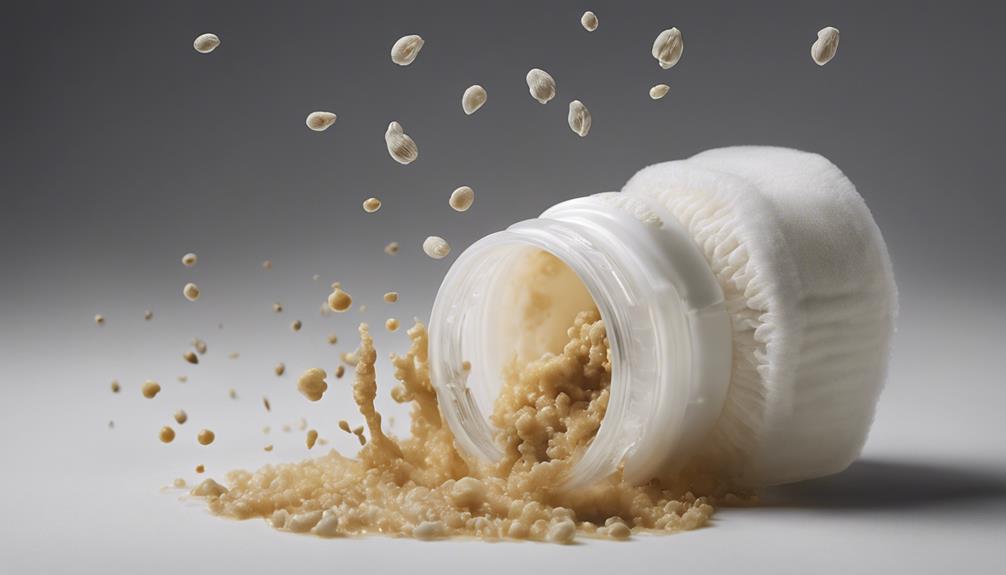Have you ever wondered why newborn poop sometimes lacks those telltale seedy bits?
Well, let's unpack this intriguing aspect of infant digestion together. Understanding the nuances of what non-seedy newborn poop signifies can provide valuable insights into your baby's health and development.
So, why does this variation occur, and what implications does it hold for your little one's digestive system?
Join us as we explore the fascinating world of baby poop and uncover the mysteries behind its ever-changing nature.
Key Takeaways
- Non-seedy poop in newborns suggests efficient milk digestion.
- Lack of seeds doesn't necessarily indicate digestive issues.
- Monitoring stool variations helps understand digestion.
- Consult healthcare for concerns about all liquid stools or poor weight gain.
Possible Reasons for Non-Seedy Newborn Poop
Non-seedy newborn poop, when observed, may suggest a quicker passage through the infant's digestive system. In the case of a breastfed baby, this may indicate more efficient digestion of breast milk. The presence of undigested milk in stools could be more visible in the absence of seed-like particles. The color of the stool, even when non-seedy, can vary within the normal range. Transitional stools in a healthy breastfed baby are often softer and more liquid-like, potentially contributing to the lack of seediness.
While non-seedy newborn poop can be normal for many breastfed infants, it's essential to be aware of warning signs that may indicate an issue. Consulting the baby's doctor is important for reassurance and guidance. Factors such as the mother's diet, the baby's feeding patterns, and changes in the gut microbiome can influence stool characteristics. By monitoring these aspects and seeking professional advice when needed, caregivers can guarantee the well-being of their newborn.
Impact on Baby's Digestive System

Incomplete digestion of breast milk in newborns can have implications for the efficiency of nutrient absorption in their digestive system. When a baby's poop lacks the seedy texture typical of breastfed babies, it can affect their digestive health in several ways:
- Nutrient Absorption: The absence of seeds in a baby's poop may signify that they aren't receiving enough hindmilk during breastfeeding, leading to less efficient absorption of essential nutrients.
- Feeding Frequency: Babies with non-seedy poop may need to nurse more frequently to make certain they're receiving adequate nutrients, which can impact both the baby and the caregiver.
- Consultation Need: The lack of seedy texture in a baby's stool could indicate a need for lactation consultation to address feeding techniques, making certain the baby's nutritional needs are met optimally.
- Developmental Concerns: Persistent absence of seedy poop might raise concerns about the baby's overall digestive development and nutrient intake, warranting further evaluation by a healthcare provider to prevent potential issues.
Health Implications of Seedy-Less Stool
The absence of seeds in a newborn's stool can provide valuable insights into their digestive process and overall health. In the first days of life, breastfed babies may have stool that lacks seeds, appearing more liquid in consistency. This can be attributed to the rapid digestion of breast milk, which may leave little time for the formation of seed-like particles.
While the presence of seeds in baby poop is often associated with the digestion of milk fat, the absence of seeds doesn't necessarily indicate an issue. Variations in the consistency of baby poop, including the presence or absence of seeds, are considered normal and can fluctuate based on factors such as the mother's diet or the baby's individual digestive system. In rare cases, the absence of seeds could be linked to a milk protein allergy, but this would typically be accompanied by other symptoms requiring medical attention.
Monitoring these variations in baby poop can offer insights into the natural digestive process during infancy.
Seeking Medical Advice

When should we consider seeking medical advice regarding the absence of seeds in a newborn's poop?
It's important to seek medical advice if your baby's stools are consistently all liquid, pasty in texture, and lack any seed-like appearance. This could indicate underlying health concerns that need to be addressed promptly.
Here are some key points to think about when deciding whether to seek medical advice:
- Consistency of Stools: If your baby's poop is consistently all liquid and lacks any seed-like texture.
- Weight Gain: If your baby isn't gaining weight as expected despite feeding well.
- Soft Stools: If your baby's stools are consistently soft and don't show signs of firming up.
- Parenting Tips: Seeking medical advice can provide you with valuable guidance on how to manage any potential issues and ensure your baby's health and well-being.
Consulting a healthcare professional can help determine the reason behind the absence of seeds in your newborn's poop and address any concerns regarding your baby's digestive health.
Tips for Monitoring Stool Changes
Upon observing variations in a newborn's poop characteristics, it is important to implement effective strategies for monitoring stool changes to make certain the baby's digestive health is maintained. Keeping a close eye on your baby's stools can provide valuable insights into their well-being. Here are some parenting tips for monitoring your baby's poop colors, consistency, and frequency, especially in the first few days after birth:
| Aspect | Normal Range | Concerning Signs |
|---|---|---|
| Color | Yellow, green, brown | Red, white, black |
| Baby's Stools | Soft, liquid, seedy | Hard, pellet-like |
| Color & Consistency | Varies over time | Sudden persistent changes |
| Baby Passes | Several times a day | Significantly less frequent |
For formula-fed babies, stool color may differ slightly from breastfed babies. Remember, if you notice any unusual or worrying changes in your baby's stool, seek advice from a healthcare provider to make sure your baby's health and well-being.
Frequently Asked Questions
What Does Unhealthy Newborn Poop Look Like?
Unhealthy newborn poop, lacking its typical seedy texture, may present as watery, mucousy, or oddly colored. This deviation could signify digestive or nutrient absorption issues. Monitoring these changes closely is important for evaluating the baby's well-being and seeking medical advice promptly.
What Makes Newborn Poop Seedy?
I comprehend why newborn poop being seedy might puzzle many. The seedy texture stems from the efficient digestion of breast milk. It's a reassuring sign of proper nutrient absorption and reflects the natural digestion process.
What Is Abnormal Poop for Newborns?
Abnormal poop for newborns can include persistent diarrhea, blood in stool, or drastic changes in color or consistency. These signs may indicate underlying issues that require medical attention. Any concerns should be promptly addressed by a healthcare provider.
What Does Milk Allergy Poop Look Like?
When a baby has a milk allergy, their poop may look green, frothy, or mucousy and might have blood or mucus. It can lead to gas, discomfort, and irritability. Skin issues like eczema can also be present.
Conclusion
To sum up, the absence of seed-like particles in newborn poop is simply a fascinating deviation from the norm in the world of infant digestion. It serves as a whimsical reminder of the intricate processes at play within our little ones' digestive systems.
So, fear not if you find yourself faced with a non-seedy diaper surprise – it's just another quirk of nature to marvel at in the wonderful world of newborn care.










